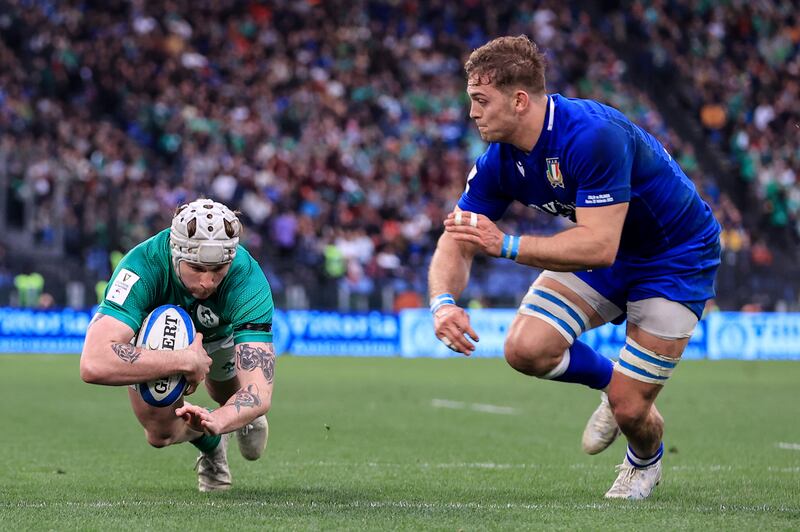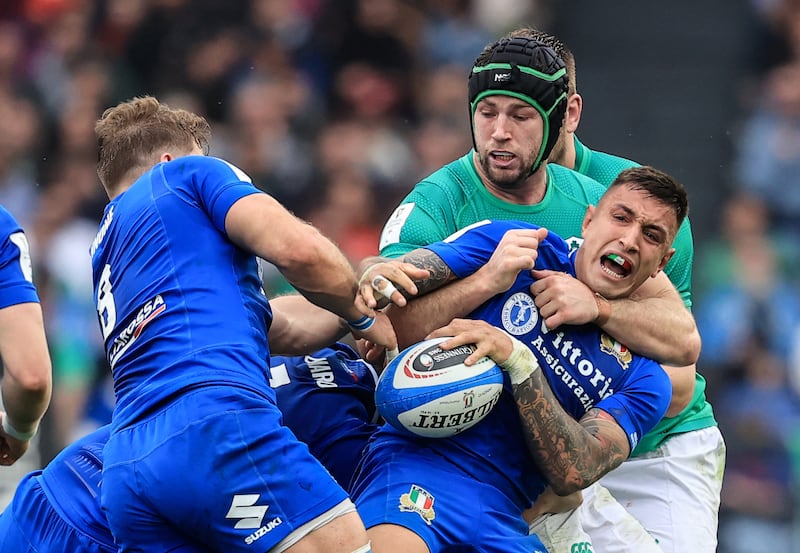It’s hard to think when the stakes were last so high for a Guinness Six Nations meeting between Scotland and Ireland as will be the case when the sides clash in the penultimate round at Murrayfield next Sunday week. Nor, certainly, when they have been set up for two such momentous matches in the same calendar year.
Ireland are the only side with an unbeaten record and thus able to retain some grand ambitions even if, mathematically, they could still finish fourth were they to lose their last two games. To put the potential prize still at stake in perspective, both Ireland and Scotland have each won just three Grand Slams in 127 years.
The two countries have also claimed 14 outright titles, and Scotland will know that a win over Ireland could set them up for a shot at a first championship since 1999 when they host Italy on Super Saturday. Ireland won their 12th Triple Crown last year and Scotland can seal their 11th Triple Crown and first since 1990 by winning at Murrayfield next Saturday week.
Then, of course, there’s the knowledge that the two sides will meet in what could be a make-or-break final Pool B game of the World Cup at the Stade de France on October 7th.
READ MORE
To give this game some added spice, there’s also been an increasing edge between Scottish and Irish sides, particularly when Glasgow play Munster or Leinster, over recent years.
Bearing all this in mind, and the six-day turnaround before facing an English side which were always likely to be better at the end of this Six Nations rather than the beginning, it’s time therefore for Ireland to go full metal jacket.
Allowing for the undoubted attacking quality of an exuberant Italian side and their marked defensive improvement after the interval, particularly in defending the short side, one ventures that Ireland will have to improve significantly for their rendezvous with Scotland in Murrayfield.

Last Saturday’s 34-20 victory in the atmospheric Stadio Olimpico was certainly not without its slick attacking play or strong goal-line defence but, as Andy Farrell conceded once again, Ireland could have been more clinical.
He specifically referred to knock-ons over and before the line, by James Lowe and Bundee Aki, albeit Ireland scored through James Ryan off the resultant goal-line drop out after the first missed opportunity.
Privately, Farrell is most likely more concerned about the missed tackles than he is letting on. The official post-match statistics put Ireland’s missed tackles at 27, since revised to 24, but whereas that figure for the entirety of last season’s championship was 66, it has already reached 79 after three rounds.
This is the fourth best in the tournament, with only Wales and England missing more, while Scotland’s tally (55) is the least. Admittedly, the increased ratio is indicative of the championship as a whole and it’s also worth stressing that in the most important defensive statistic, namely tries conceded, Ireland have thus far been comfortably the best.
As well as scoring the most tries, 13 to date, with Scotland next on 12, Ireland’s concession of just four tries betters England (seven), Scotland (eight), France (nine), Wales (12) and Italy (14).
Last Saturday highlighted how important the absent Garry Ringrose is to this team in the key defensive position of outside centre. Ringrose has started 15 of Ireland’s last 18 Tests since the outset of the 2021 Six Nations, with Robbie Henshaw shifting across to 13 on each of the other three occasions, including the 2021 Six Nations win over England and the third Test in New Zealand.
Ringrose also replaced the stricken Henshaw within five minutes against Fiji last November, and has played plenty of rugby this season – 1,246 minutes in total for province and country.
With Henshaw not available last Saturday, Ireland were compelled to go with Stuart McCloskey and Aki, who was making his first start at 13 for Ireland after the previous 32 had been at inside centre.
Although he was often brilliant in attack, that was always going to be a huge ask for Aki defensively, and so it proved. In the unlikely event that Henshaw and Ringrose are ever ruled out, or rested together again, it’s hard to envisage the McCloskey-Aki partnership being given another airing.
Instead, were such a scenario to come pass, it may well be that Jimmy O’Brien steps in at 13. Come to think of it, there’s no proven alternative to Hugo Keenan at fullback or indeed Josh van der Flier at openside. Presumably O’Brien or Mack Hansen are options for the former but, as for the latter, Van der Flier’s understudy for the last couple of seasons, Nick Timoney, has been one of those omitted from the squad.

The uncapped Scott Penny has been called up instead but, with the World Cup in mind, one wouldn’t rule out Will Connors coming back into the equation were he to return to full fitness.
It was Connors’ brief time as the incumbent openside during the 2021 Six Nations which sparked the dramatic upturn in the performances of the World Player of the Year, Van der Flier, whose display last Saturday was in keeping with that title.
In the short-term, presuming that Henshaw and Ringrose are both fit for the final two games, they’re likely to resume their partnership, and ditto Johnny Sexton alongside either Jamison Gibson-Park or Conor Murray. Tadhg Furlong could well start too, with Dan Sheehan and Peter O’Mahony perhaps restored as well, not least so Caelan Doris can revert to number eight.
For sure, it would be a risk to throw in a quintet of players who were ruled out last week, and in the case of Henshaw and Furlong, who last played in November and December, while Gibson-Park has been inactive since January.
But history has repeatedly taught us that the standard of training within the Irish squad is of a sufficiently high standard to bring players back up to speed, even when making their seasonal returns after lengthy absences.
Furlong had only played 40 minutes before starting all three of Ireland’s wins over South Africa, Fiji and Australia, while Gibson-Park started the latter two having not played a minute’s rugby since the summer tour.
And the magnitude of what’s immediately ahead demands that Ireland don’t die wondering.
















